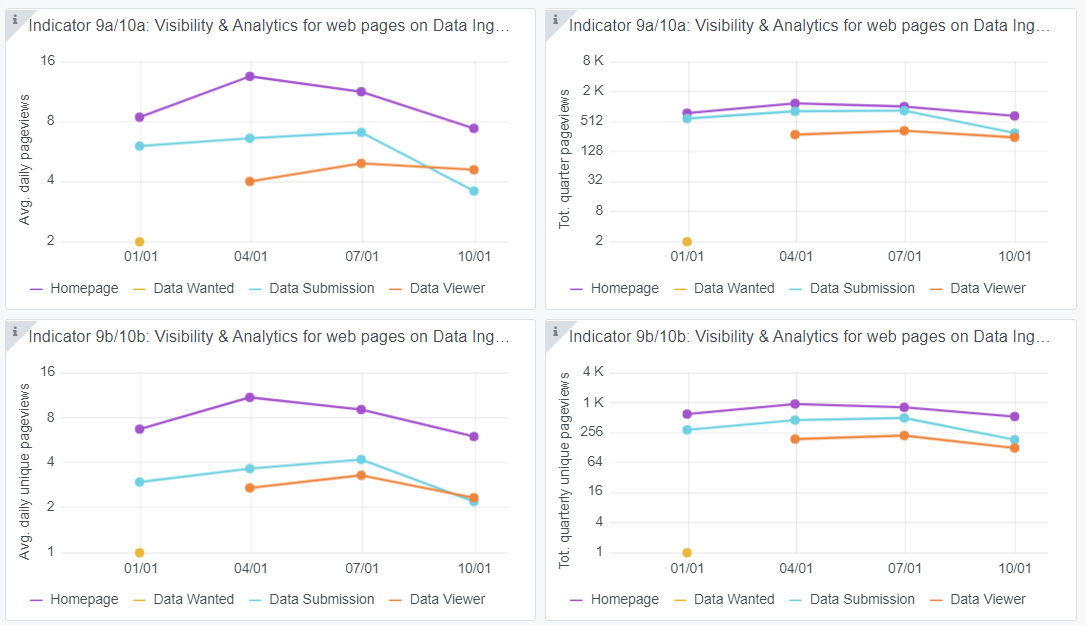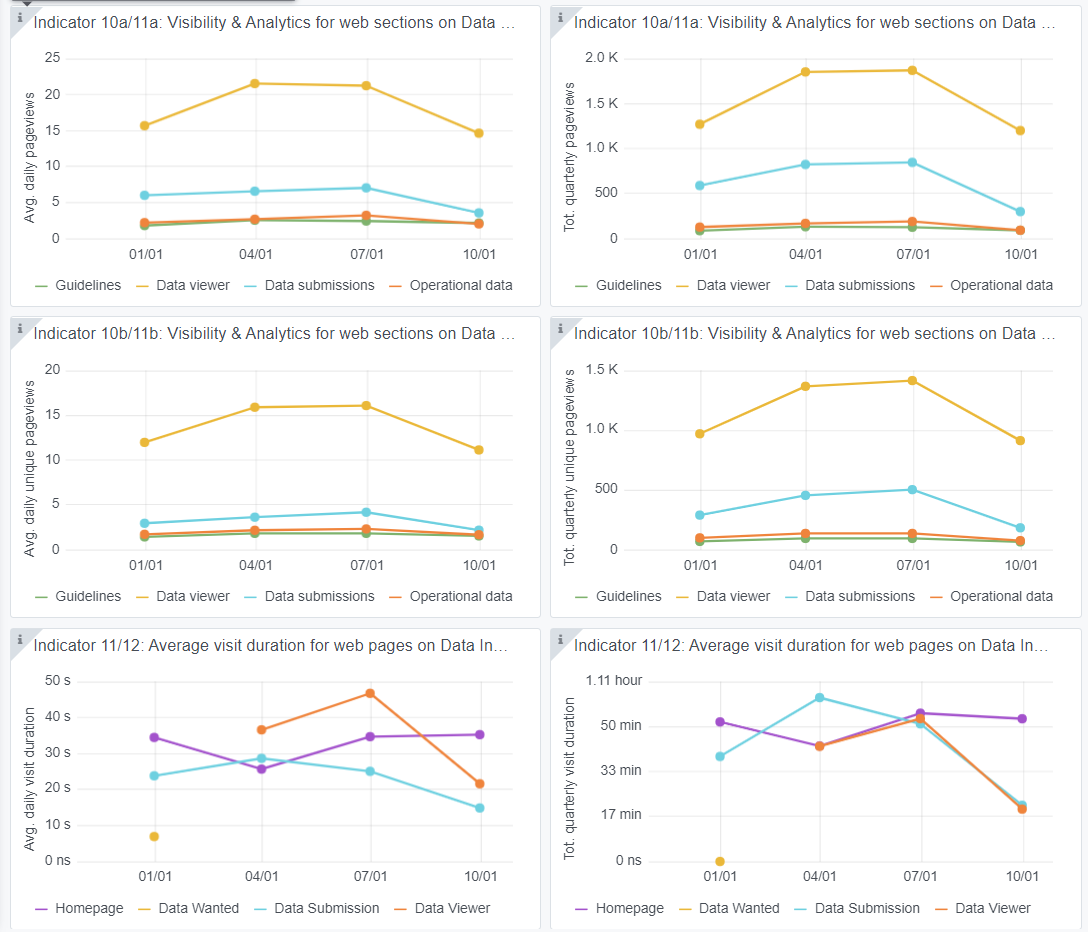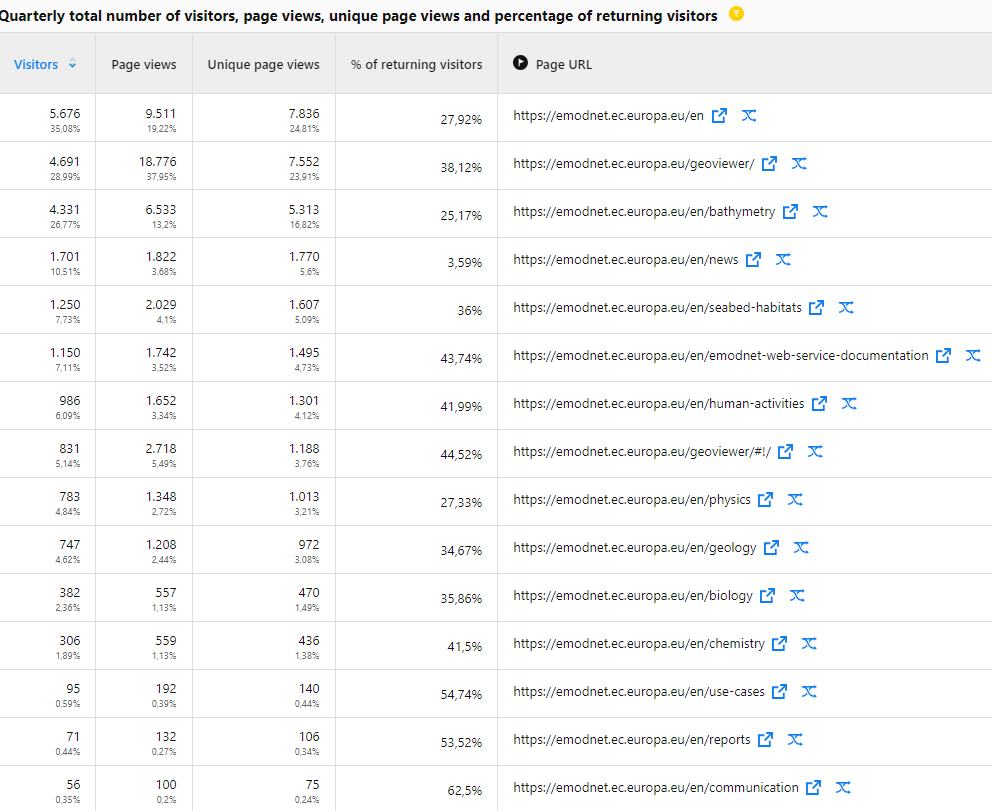EMODnet progress overview
General progress highlights
EMODnet centralisation of the thematic portals may be complete, but EMODnet services continue to evolve. Discover the enhancements and latest technical upgrades to the EMODnet Map Viewer, brought to you by the Central Portal Technical team in Q3 2023. These upgrades improve marine data discovery and visualization, including new map projections, customized parameter exploration, offering a more efficient and precise marine data exploration than ever before.
On 26-27 September 2023, EMODnet together with EC DG MARE organised a workshop on “EMODnet marine data for coastal tourism”. The workshop was attended by over 42 coastal tourism experts with representatives from diverse sectors including research, policy, marine data services and non-governmental agencies. EMODnet was well represented by thematic experts from geology, human activities, physics, Data Ingestion, Central Portal and the EMODnet Secretariat. The agenda included a demonstration of the latest EMODnet services, use cases of how the coastal tourism sector uses EMODnet data and data products, and dialogues on data requirements and data sharing. A report will follow on the EC Maritime Forum.
The report on the Open Sea Lab (OSL) 3.0 Hackathon is available for download and the OSL 3.0 video is available for viewing. Both resources provide an in-depth summary of the event which took place in early Spring 2023, thereby outlining the key results, outcomes and innovations that were conceived during the event.
Specific progress and achievements of the thematic data assembly groups
- There was an increase in the number of Common Data Index (CDI) entries from 41,574 to 42,153 for EMODnet Bathymetry. In the coming months, more new CDI and Composite Digital Terrain Models (CDTM) are expected, as well as Satellite Derived Bathymetry files. The Collaborative Virtual Environment, a digital environment created in the previous contracts of EMODnet Bathymetry with high performance computers and hosting the software GLOBE[1], is now at such a mature level that it will be integrated in the production workflow for generating the new EMODnet Digital Terrain Model (DTM). A series of workshops took place with all consortium partners to inform them about the latest developments and functions of Ifremer’s software packages GLOBE, Sextant[2] and Mikado[3], which are important in the EMODnet DTM production workflow.
- The first data harvest of the new EMODnet Biology contract brought 15 new and four updated datasets from both partners and ad hoc data providers, increasing the database with more than 230,000 new occurrence records distributed around the Atlantic and Arctic Oceans and the Mediterranean and North Seas. Building on the existing offer of seabird and marine mammal data already offered by EMODnet, efforts are ongoing to further develop a collaboration with seabird experts and mammal experts, e.g. by offering to host any products they may have created that address the impact of coastal human infrastructures in migrating species. The thematic is planning a workshop in early 2024 involving invited experts from the various Regional Sea Conventions (RSCs), aimed to raise awareness of EMODnet and to collect feedback and needs from the RSCs. In addition, input from EDITO-INFRA is expected to help the consortium improve the data products in terms of reproducibility and also provide input on what the EU Digital Twin Ocean (DTO) users might require.
- EMODnet Chemistry created two new data collections for eutrophication and pollutants, and four new data collections for marine litter. The continuous interaction with the partnership results in a constant updating of existing data and metadata entries. The DIVA (Data-Interpolating Variational Analysis) maps for eutrophication and associated metadata descriptions were published and described in the EMODnet catalogue. Existing marine litter maps were updated with new data, and three new products were created for seafloor litter and 16 for micro-litter. Concerning contaminants, four new types of maps were produced. All aforementioned new maps will be ready for publication soon. Similarly, a new version of the regional aggregated, validated and harmonised data collections for eutrophication and pollutants will be published in the Central Portal. The thematic lot organised a third meeting with the Board of Marine Strategy Framework Directive (MSFD) experts with representatives from the four RSCs, Joint Research Centre (JRC), European Environment Agency (EEA) and other organisation to discuss the new marine litter data products.
- During the reporting period, EMODnet Data Ingestion received 43 submissions, pushing the total number of received submissions since the start of the project to 1,509. The total number of published data submissions since the start of the project increased from 1,334 to 1,367, of which the number of elaborated data submissions went from 606 to 624. New operational stations have been integrated into the system, meaning that machine-to-machine connections are being set up between the provider and EMODnet so that new data are available as soon as the providers start collecting/transferring data. Among the new stations are a Spanish river data provider AUGAS DE GALICIA, XUNTA DE GALICIA; the Integrated Marine Observing System-Australian Ocean data Network (IMOS-AODN); Lyse AS operating power plants in Norway; and new buoys from the International Arctic Buoy Program (IABP). The work on Deliverable 4.6 resulted in a searchable database on the availability of license data from over 20 European countries; the majority of the data pertains to Environmental and Impact Monitoring. The next step is the development of a roadmap aimed at achieving a more harmonized approach.
- The data submitted by the EMODnet Geology partners were added to the different EMODnet Geology products, which were updated on the Central Portal by the end of September, i.e. the first phase of the contract. Geology’s contract was renewed in September for another period of 24 months.
- EMODnet Human Activities examined the possibility to extract relevant sides from the UNESCO World Heritage List, and contacted Eurostat to get access to microdata on nights spent by tourists in coastal areas. Exchanges took place with EC DG MARE on the possibility to make available more fishery-related data. The Route Density maps were update with data up to September 2023. Marine Spatial Plans from Estonia and Spain were added to the Marine Spatial Planning dataset. The Environment theme was enriched with an entirely new dataset on Emerald network sites.
- EMODnet Physics reorganised the EMODnet Physics ERDDAP into two endpoints, one for offering products and one for offering data collections. For each data collection, a metadataset will be published. Furthermore, the thematic lot focused on improving the user experience when downloading in situ data from EMODnet Physics layers in the EMODnet Map Viewer, i.e. the platform box that opens when clicking a platform, the data were presented as a HTML page within the box. This tool was enhanced in terms of the clarity of metadata presentation and updated with a new data downloading feature that offers users data in various formats, such as netCDF, the community-standard format, in addition to the already available CSV format.
- EMODnet Seabed Habitat’s contract was renewed for another period of 24 months, starting September 2023. SYKE took on the coordinator role, which was previously taken up by JNCC. Following feedback from partners and EMODnet Biology, EMODnet Seabed Habitats further refined their habitat point submission guidance document to facilitate the submission of partner habitat point data to EMODnet Biology. A new version of the EUSeaMap 2023 has been developed. Compared to the previous version, it has been extended to the Caribbean Sea and Caspian Sea, and it contains the integration of new data on seabed substrate from EMODnet Geology and bathymetry from the EMODnet Bathymetry DTM 2022. New combined, harmonized data products for the extent of wetland type and Essential Ocean Variable mangrove cover have been created. Furthermore, three existing EOVs datasets (seagrass, macroalgae and hard corals) were updated with new data and where appropriate extended to the Caribbean Sea region. Also updated were the coralligenous and biogenic substrate composite layers.
[1] Tool used to upload, visualise and inspect (quality assessment) regional DTMs for anomalies
[2] Software exploration tool
[3] Mikado is a versatile XML editor, provided by SeaDataNet, to prepare CDI XML entries
EMODnet data portal usage
User visit statistics
Since centralisation and thus as of 25 January 2023 onwards, statistics on user visits to the EMODnet Central Portal are collected through Europa Analytics. Below we provide the quarterly total (for the period April – June 2023) or daily number of page views[1] (in absolute number) of the EMODnet Central Homepage, a selection of webpages, and each of the thematic entry pages.
- Compared to the previous quarter, a decrease of 19% was recorded in the number of page views of the EMODnet portal homepage (from 11,320 to 9,511 page views). This is likely due to Q3 2023 being the summer months when many professional users of EMODnet take extended vacation;
- On average, the page containing web services documentation received between 20 and 60 page views per day. The news section received on average 25 page views per day;
- The web pages Web services documentation, Use cases, Reports and Communication continued to have a high percentage of returning visitors (between 44 and 63%);
- Of all entry pages, EMODnet Bathymetry remained the most visited one in the past quarter. The second most viewed entry page was again the one of Seabed Habitats, followed by Human Activities, Physics, Geology, Biology and Chemistry (with no change in order compared to the previous quarter);
- Specific numbers for the thematics are:
- A decrease of 23% was recorded in the number of page views for the Bathymetry entry page (from 8,066 to 6,533);
- The number of page views for the Biology entry page decreased by 47% (from 820 to 557);
- A decrease of 25% was recorded in the number of page views for the Chemistry entry page (from 744 to 559);
- The number of page views for the Geology entry page decreased by 36% (1,642 to 1,208);
- The number of page views for the Human Activities entry paged decreased by 17% (from 1,985 to 1,652);
- The number of page views for the Physics entry page decreased by 27% (from 1,716 to 1,348);
- The number of page views for the Seabed Habitats entry page decreased by 15% (from 2,335 to 2,029).
The Data Ingestion Portal is not yet centralised, hence web traffic to their portal is currently still being tracked using Matomo. An average of 7 daily page views was recorded for the Homepage, of which 5 were for the Data Viewer.
[1] The number of times a page was visited.
Statistics on usage of EMODnet thematics2
Since the second quarter of 2023 onwards, there has been a change from reporting on download metrics by the individual thematic portals to metrics being centrally reported from the new unified portal. This affects the thematics in different ways, depending on their technical back-end infrastructure. The new unified metrics are still being developed, and will be fully deployed over the next few quarters. Some caution is advised with regards to the metrics at this stage.
Number of data downloads3
- There was a decrease of 99% in number of downloaded CDIs from EMODnet Bathymetry compared to previous quarter, i.e. from 388 to 4 CDI downloads;
- EMODnet Chemistry CDI downloads increased from 1 to 11,879.
- EMODnet Data Ingestion recorded a decrease of 2% in number of data download transactions, from nearly 251 to 246.
- EMODnet Human Activities displayed a mixture of dataset download increases and decreases depending on the parameter. The total number of dataset downloads for all subthemes remained almost constant, with 2,062 in Q3 compared to 2,068 in previous quarter. Among the most downloaded datasets were the Energy Wind Farms (from 258 to 214 dataset downloads), Telecommunication Cables Actual Route Locations (126 downloads), and Fishing Intensity (from 162 to 171).
- For this quarter, EMODnet Seabed Habitats observed an increase in the number of manually downloaded records from the dataset Collection of Classified Points from 10,859,850 to 28,580,522.
Number of data product downloads4
- A decrease was recorded in the number of downloads of EMODnet Bathymetry DTM tiles (from 13,201 to 7,104 downloads) and in number of downloaded High-Resolution DTMs (from 2,160 to 1,279 downloads).
- For all EMODnet Geology data products, the number of data product downloads increased. Increases ranged from 7% (Seafloor Geology, from 327 to 349 file downloads), to 74% (Coastal Migration, 90 to 157 file downloads)) to 391% (Minerals, 70 to 344 file downloads)).
- For EMODnet Human Activities, Vessel Density Maps 870 datasets were downloaded this quarter, representing a decrease of 20% since the previous quarter (1,084 downloads). Similarly, the Route Density Maps were downloaded 560 times, compared to 667 downloads in the previous quarter, representing a decrease by 16%.
- A decrease in the number of product download transactions through ERDDAP (from 1,575,052 to 268,966) were observed for EMODnet Physics.
- Increases were observed in the number of downloaded datasets for EMODnet Seabed Habitats. The most downloaded product dataset was Habitats - seabed habitats (including coastal wetlands) - collection of classified maps (from 52,175 to 86,274 dataset downloads); the least downloaded dataset was Habitats - seabed habitats (including coastal wetlands) - collection of models (from 7 to 74 downloads).
[2] For thematics which provided this information.
[3] Disclaimer: please note that percentages given can reflect small as well as large changes in the number of data and data product downloads. In most cases however it is difficult to provide an actual explanation for the downloading behaviour of users.
[4] Disclaimer: please note that percentages given can reflect small as well as large changes in the number of data and data product downloads. In most cases however it is difficult to provide an actual explanation for the downloading behaviour of users.
Upcoming EMODnet meetings and events
The main EMODnet meetings planned for the coming quarterly period in 2023 is:
- The EMODnet Open Conference and Jamboree 2023 will be held on 29-30 November 2023, in Brussels, Belgium. The full programme is available online and features Sessions where all EMODnet thematic and data ingestion Coordinators will speak, together with a wide diversity of EMODnet stakeholders from data providers and funders to EMODnet users, including the public and private sectors. Live streaming will be available for the plenary sessions. The event Master of Ceremonies will be Karen Coleman;
- The 19th EMODnet Steering Committee Meeting, taking place back-to-back with the EMODnet Open Conference 2023, on 1 December 2023.
More information
More information about EMODnet’s resources is available at the following links:
- EMODnet Data and Data product portfolio: https://emodnet.ec.europa.eu/en/data-portfolio
- EMODnet for Business brochure: https://emodnet.ec.europa.eu/en/emodnet-business-brochure
Thematic portals
- EMODnet Bathymetry - https://emodnet.ec.europa.eu/en/bathymetry
- EMODnet Biology - https://emodnet.ec.europa.eu/en/biology
- EMODnet Chemistry - https://emodnet.ec.europa.eu/en/chemistry
- EMODnet Geology - https://emodnet.ec.europa.eu/en/geology
- EMODnet Human Activities - https://emodnet.ec.europa.eu/en/human-activities
- EMODnet Physics - https://emodnet.ec.europa.eu/en/physics
- EMODnet Seabed habitats - https://emodnet.ec.europa.eu/en/seabed-habitats
Data Ingestion Service
- EMODnet Data Ingestion - www.emodnet-ingestion.eu
Sea-basin Checkpoints resources
For an overview of and access to information and outputs from each of the Sea-basin Checkpoints (projects ended), visit: https://emodnet.ec.europa.eu/en/checkpoints
- North Sea checkpoint - https://emodnet.ec.europa.eu/en/checkpoint/north-sea
- Mediterranean checkpoint - https://emodnet.ec.europa.eu/en/checkpoint/medsea
- Artic checkpoint - https://emodnet.ec.europa.eu/en/checkpoint/arctic
- Atlantic checkpoint - https://emodnet.ec.europa.eu/en/checkpoint/atlantic
- Baltic checkpoint - https://emodnet.ec.europa.eu/en/checkpoint/baltic
- Black Sea checkpoint - https://emodnet.ec.europa.eu/en/checkpoint/black-sea





